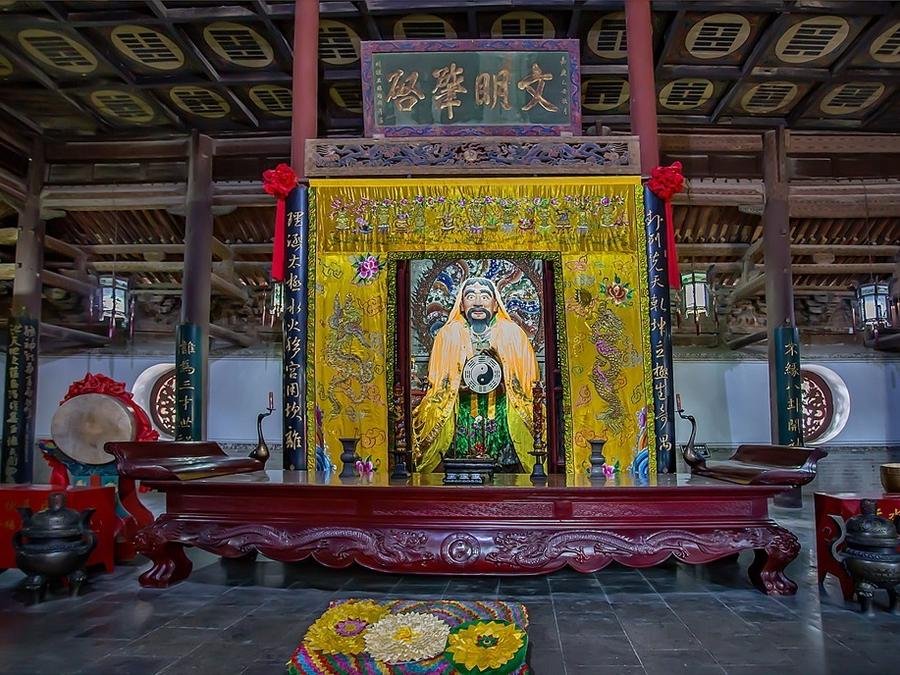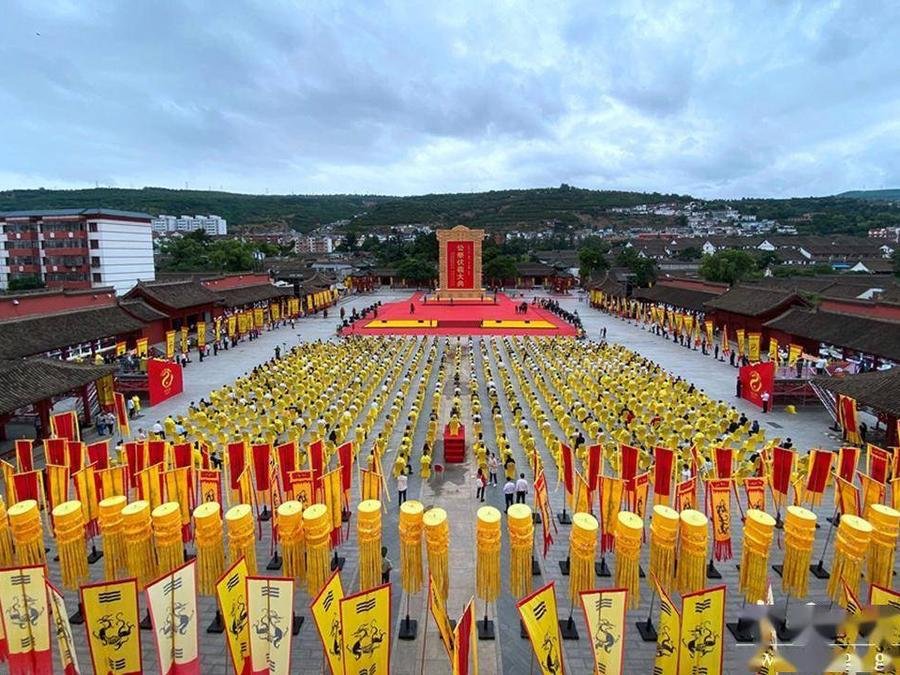Fuxi Temple (伏羲庙), also known as Taihao Palace (太昊宫), is a renowned ancient architectural complex located in Tianshui, Gansu Province, China. Built between 1483 and 1484 during the Ming Dynasty, it is the largest Fuxi worship site in China.
Covering an area of 13,000 square meters, Fuxi Temple is known for its grand and expansive layout, consisting of a series of courtyards arranged in a traditional palace-style format. The temple complex is structured with four main courtyards, featuring 76 rooms that are arranged along a central north-south axis.
The architectural design of Fuxi Temple reflects the significance of Fuxi as the legendary first emperor of ancient Chinese history. Visitors enter through a majestic archway, passing through several gates and halls, including the Xiantian Hall and the Taiji Hall. The entire complex exudes a sense of solemn grandeur, with its well-preserved structures and serene environment offering a glimpse into traditional Chinese architectural and religious practices.
Table of Contents
- Basic Information
- Location and Transportation
- Highlights of Fuxi Temple
- Vlog about Fuxi Temple
- Other Attractions in Tianshui Urban Area
Basic Information
| Estimated Length of Tour | 1 – 2 hours |
| Ticket Price | 20 RMB |
| Opening Hours | 8.00 – 17.30 |
Location and Transportation
Fuxi Temple is located at 110 Fuxi Road, Qinzhou District, Tianshui City, Gansu Province, China. To get there, you can take bus 5, 21, 22, 80, or 84, get off at Fuxi Temple Stop (伏羲庙站), and walk about 350 meters to the west.
Highlights of Fuxi Temple
Monumental Archway

Originally, Fuxi Temple had three archways: “开天明道 Kai Tian Ming Dao” (Opening Heaven to Illuminate the Way), “继天立极 Ji Tian Li Ji” (Continuing Heaven and Establishing the Principles), and “开物成务 Kai Wu Cheng Wu” (Opening the World to Accomplish Tasks). Today, only the “Kai Tian Ming Dao” archway remains. It stands in front of the main gate on a platform. Created in the 2nd year of the Jiajing era (1523), it was rebuilt several times during the Qing Dynasty, most notably in the Qianlong era (1741), and again in the Jiaqing era (1805-1807) and the Guangxu era (1885-1887). The archway stands 11 meters tall with a width of 3 bays, totaling 10.5 meters. It features a three-eaved roof and maintains its original Ming Dynasty architectural style.
Xiantian Hall

Also known as the Main Hall or Grand Hall, the Xiantian Hall is located at the rear center of the middle courtyard, serving as the main building of the Fuxi Temple complex. Originally built as the Taihao Palace during the Ming Dynasty (1483-1484), though the exact location of the original palace may differ from the current hall. Expanded in the 2nd year of the Jiajing era (1523), it was named “Xiantian” in reference to Fuxi’s Eight Trigrams. The hall has undergone multiple renovations during the Qing Dynasty, including in the Shunzhi era (1653), Qianlong era (1739), Jiaqing era (1805-1807), and Guangxu era (1885-1887), resulting in its current form. Spanning 7 bays wide (26.4 meters) and 5 bays deep (14.05 meters), the hall features a grand double-eaved hip roof adorned with dragon-kiss ridge decorations and intricate carved details. Inside, the hall houses a statue of Fuxi over 3 meters tall, holding the Eight Trigrams with a commanding presence in the shrine. Decorative elements include auspicious animal motifs like dragons, phoenixes, and cranes, as well as floral patterns of peonies, mugwort leaves, and pine branches, showcasing exquisite craftsmanship. The hall ceiling is decorated with painted diagrams of the I Ching hexagrams and the River Chart (Hetu) and Fuxi’s Eight Trigrams, blending decorative art with Fuxi’s legacy.
Festivals and Celebrations

In Tianshui, the 16th day of the first lunar month is celebrated as Fuxi’s birthday. According to tradition, people visit Fuxi Temple for worship during this Fuxi Temple Fair, a grand occasion to honor the cultural ancestor Fuxi. This tradition, dating back over 2,000 years, celebrates Fuxi’s role in the origins of Chinese civilization. In 1988, the Tianshui Municipal Government reinstated the public worship of Fuxi, and in 2006, the “Taihao Fuxi Ceremony” was listed as one of the first national-level intangible cultural heritages. The festival includes traditional rituals, performances, and community gatherings, providing a glimpse into the rich cultural heritage and spiritual significance associated with Fuxi Temple.







You need to present your ID card to purchase tickets at the Fuxi Temple, and facial recognition is required for entry! Inside, the ancient trees are majestic and the air is filled with incense! The temple, a well-preserved Ming Dynasty structure, enshrines the Great Emperor Fuxi, who is considered the cultural ancestor of all Chinese people and ranks among the Three Sovereigns (三皇). The temple features a rich variety of artistic forms, including wood carvings, stone carvings, and murals! Although… Read more »
I took a train from Pingliang to Tianshui Railway Station and then took a taxi to a hotel near Tianshui South Station (as it is convenient for taking the high-speed train to Lanzhou West Station later). After settling in, I took a taxi to the Fuxi Temple. I was surprised to find that the plants inside were very green, and the flowers were beautifully blooming! This created a striking contrast with the barren mountains along the way.
On the 16th day of the Lunar New Year, I visited the Fuxi Temple in Tianshui and was left speechless by the stunning sacrificial ceremony. The procession was adorned in traditional attire, exuding a solemn and dignified atmosphere. Every movement they made was meticulous, as if they were having a dialogue with history. Accompanied by ancient music, the chief officiant recited the sacrificial texts with a resonant and powerful voice. The crowd around me displayed various forms of reverence; some… Read more »
Every year on the 16th day of the New Year, the Fuxi Temple in Tianshui holds a grand temple fair. The highlight I’m looking forward to the most is the “sticking of the little red people”! This is an ancient blessing custom that is said to bring good luck and ward off misfortunes for an entire year if you participate today! As soon as you enter the Fuxi Temple, you’ll see many stalls for the little red people, divided by… Read more »
The entrance ticket is only twenty yuan, which is quite cheap compared to other attractions in the Maijishan Scenic Area. However, I was shocked after just five minutes inside. After a short walk from the entrance, I immediately reached the first main hall. Passing through that, I encountered the second hall, and then the backyard. For someone like me, who does not have any religious beliefs, it felt like I just paid twenty yuan to leave almost immediately. While researching,… Read more »
The Fu Xi Temple is located right across from the ancient city of Tianshui. You can visit the Fu Xi Temple in the afternoon and explore the ancient city in the evening. The Tianshui Museum is situated inside the Fu Xi Temple, so you can visit both places together.
Near the Fuxi Temple, there is a popular restaurant recommended by users on Dianping called Mark’s Hand-Pulled Lamb (马克手抓羊肉). There’s also a barbecue spot nearby. Behind the Vienna Hotel, you’ll find a commercial street with a variety of delicious food options. Local specialties include chili noodles and apples.